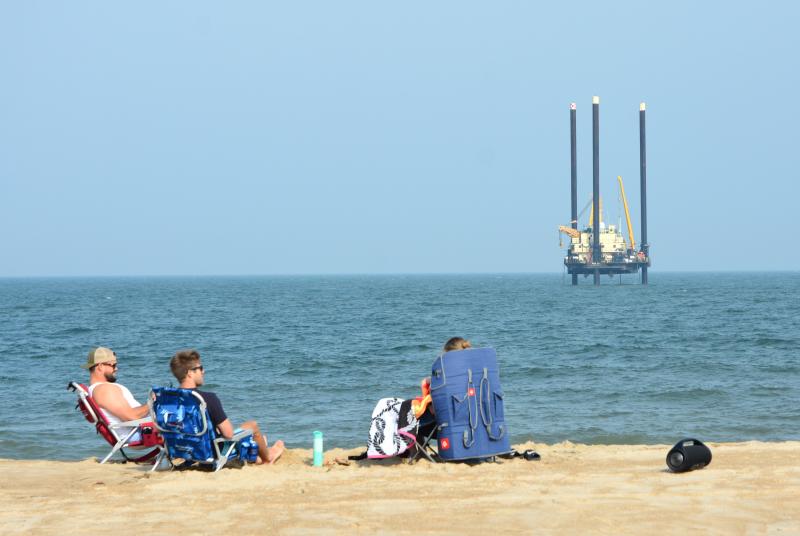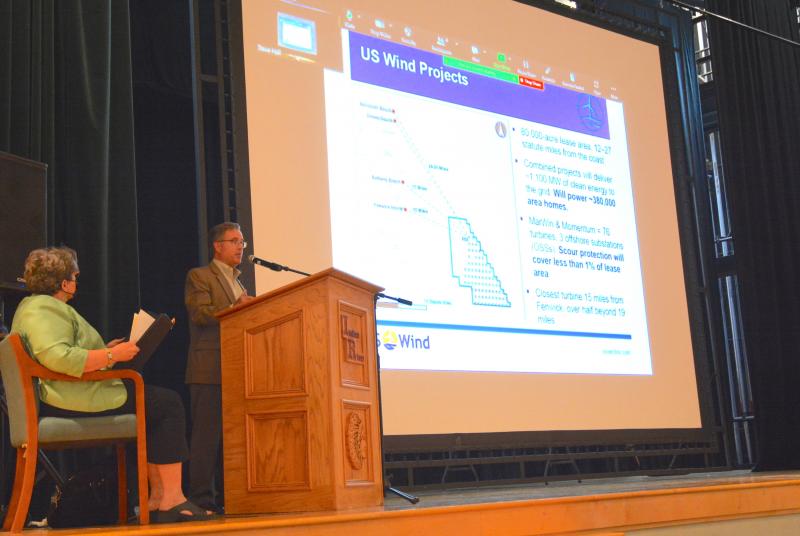Wind power issues to ponder is theme of symposium

Loss of viewshed, impacts to commercial fishing and effects on animal life were the primary concerns about offshore wind brought up during a May 20 symposium in Dagsboro. However, clean energy, improved infrastructure and job creation were also topics of discussion.
Hosted by the Fenwick Island Environment Committee, the symposium took place in the auditorium of Indian River High School. It was publicized as seeking a responsible solution for offshore wind, and it wasn’t a back-and-forth debate. It involved presentations from about a dozen individuals – a representative from each of the offshore wind companies looking to build wind farms off the coast of Maryland and Delaware, and individuals each with a specific concern about large-scale wind farms.
The Maryland Public Service Commission has twice awarded Offshore Renewable Energy Credits to Ørsted and US Wind for wind farms in federal waters off the coasts of Delaware and Maryland. The Ørsted area stretches from Rehoboth Beach to Fenwick Island, while the US Wind area is primarily due east of Ocean City, Md. Both projects are expected to produce roughly 1,000 megawatts of power when fully constructed.
The two wind power company representatives began.
Mike Dunmyer, US Wind’s Delaware development manager, said the project’s construction and operations plan is being reviewed by the Bureau of Ocean Energy Management. The expectation is that the document will be released soon for public consumption, and that will trigger a two-year public review process, he said. Dunmyer said a new energy source, improved infrastructure, local investment and jobs are going to benefit Sussex Countians. “Climate change is affecting us today, and it’s going to get worse if it’s not addressed,” he said.
Brady Walker, Ørsted Mid-Atlantic market manager, said the company participates in community engagement events like the symposium because Ørsted believes in being a good neighbor. Ørsted is going to be responsible for the area throughout the entire lifecycle of the project, he said.
Walker said the lease areas cannot be moved, but the outlines of the lease areas are not necessarily indicative of where the turbines will be.
Ocean City Mayor Mike Meehan was the first person with concerns to speak. He said he’s not against wind farms, but he would like to see the turbines pushed farther back from the coastline as has been done in the federal lease areas near other states. Tourism is the one industry Ocean City has, and there would be a dramatic impact if the 850-foot-tall turbines were visible from the beach, he said.
Representing the commercial fishing industry for New England-area states, Meghan Lapp said it’s impossible for trawl nets to maneuver through the turbines because the boats and the nets aren’t in the same place. She said the expectation would be a complete loss of fishing near the wind farms within the next 30 years.
Lapp also talked about radar interference because the turbines produce false reflections, and how cables become exposed.
Bonnie Brady, Long Island Commercial Fishing Association executive director, said there’s anecdotal evidence that construction of wind farms has a negative effect on resident marine life.
David Stevenson, Caesar Rodney Institute Center for Energy & Environmental Policy director, said there are other, less expensive and more efficient options available for renewable energy. Wind power is exceedingly expensive, while solar power is about the same cost as nonrenewable sources, he said. Stevenson acknowledged the creation of a few dozen permanent jobs from wind farms, but said it wouldn’t be worth it if the turbines negatively affected Delaware’s tourism economy even a few percentage points.
Chris Flood has been working for the Cape Gazette since early 2014. He currently covers Rehoboth Beach and Henlopen Acres, but has also covered Dewey Beach and the state government. He covers environmental stories, business stories, random stories on subjects he finds interesting and has a column called ‘Choppin’ Wood’ that runs every other week. Additionally, Chris moonlights as the company’s circulation manager, which primarily means fixing boxes during daylight hours that are jammed with coins, but sometimes means delivering papers in the middle of the night. He’s a graduate of the University of Maine and the Landing School of Boat Building & Design.

















































